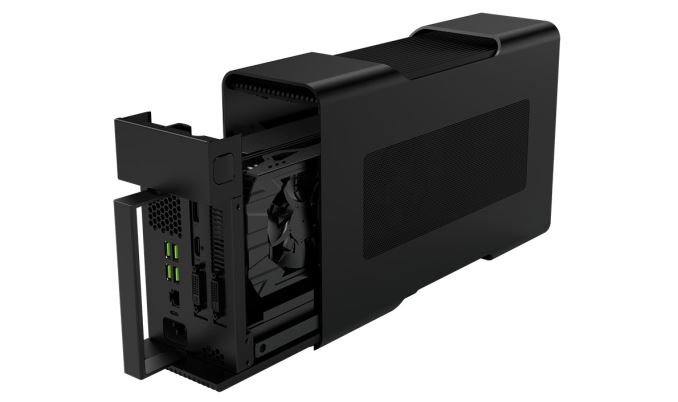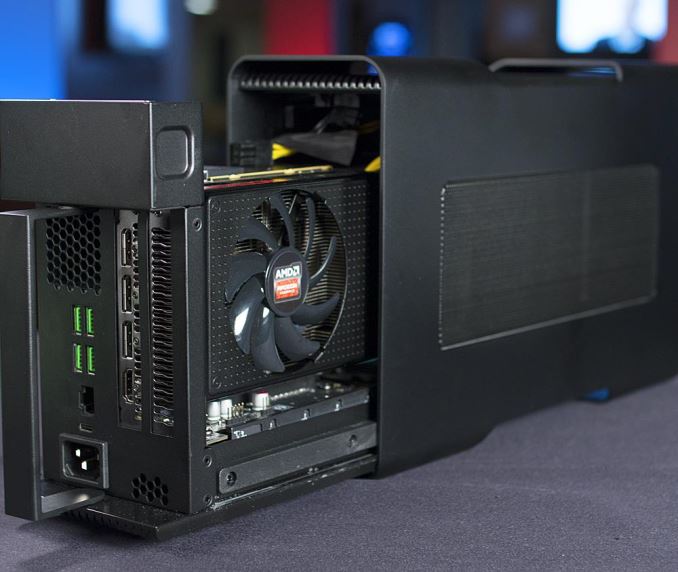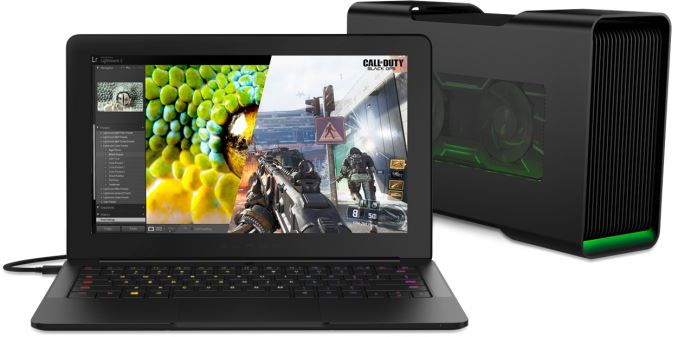Razer Core Thunderbolt 3 eGFX Chassis: $499/$399, AMD & NVIDIA, Shipping In April
by Ryan Smith on March 16, 2016 9:00 PM EST- Posted in
- GPUs
- Thunderbolt
- Razer
- Thunderbolt 3
- eGFX

Back at CES 2016, Razer announced their Core Thunderbolt 3 external graphics (eGFX) chassis. Built around the new Thunderbolt 3 standard and its long-awaited official support for external video cards, the Razer Core is the first eGFX chassis to hit the market. We got a bit more information about it with last week’s AMD XConnect announcement, and now today at GDC Razer is releasing the full details on functionality, compatibility, and availability.
Jumping right into things, the Razer Core is what can be considered a full size eGFX chassis. The unit is large enough to accommodate a double-wide video card up to 12.2 inches long, which covers almost every video card on the market. The only notable exceptions here are cards that use external radiators (e.g. Radeon R9 Fury X) and the small number of ultra-high-end triple-wide card designs such as some of MSI’s Lightning cards. The toolless design is able to handle both open air and blower type video card coolers, however given its smaller size relative to a full PC case, I think it’s going to be worth looking into just how well open air cards do.
| Razer Core Thunderbolt 3 eGFX Chassis Specifications | |||
| Max Video Card Size | Double-Wide, 12.2" Long (310 x 152 x 44mm) |
||
| Max Video Card Power | 375W | ||
| Connectivity | 4x USB 3.0 1x Gigabit Ethernet Laptop Charging via Thunderbolt 3 |
||
| Chassis Size | 4.13 x 13.9 x 8.66 inches (105 x 353 x 220mm) |
||
| Internal PSU | 500W | ||
| System Requirements | Thunderbolt 3 eGFX Certified PC Thundebolt 3 w/Active Cable Windows 10 |
||
| Shipping Date | April 2016 | ||
| Price | $499 ($399 w/Razer laptop) | ||
The chassis itself measures 4.13” x 13.9” x 8.66” and contains an internal 500W PSU, with Razer rating it to drive up to a 375W video card. At 10.89lbs it is technically portable, though clearly not ideal for the task given its handle-less design. Rather Razer intends this to be a fixed docking station for laptop users, as demonstrated both by the additional ports made available on the Core – 4x USB 3.0 Type-A and a gigabit Ethernet port – and by the fact that it’s capable of charging laptops over its Thunderbolt 3 connection.
The Core is the first of what we expect will be several TB3 eGFX chassis. As we briefly mentioned in our AMD XConnect overview, the Core is essentially the pathfinder product for the TB3 eGFX standard, with Intel, AMD, and Razer working together to put together the first devices and validate them. Consequently the Core is so far only validated to work with two laptops – Razer’s Blade Stealth and new 2016 Blade – however it should work with any future laptops that are also eGFX certified.
As for video card compatibility, while the Core was initially developed with Intel and AMD, Razer has confirmed that the chassis does support both AMD and NVIDIA video cards. The full compatibility list is posted below, but for AMD cards it’s essentially all of their latest generation (290 series and newer) video cards. Meanwhile on the NVIDIA side all of the company’s Maxwell 1 and Maxwell 2 cards are supported, starting with the GTX 750 Ti. Though given the price of the Core, it goes without saying that the expectation is that it will be paired up with high-end video cards as opposed to lower-end models.
| Razer Core Video Card Compatibility List | |||
| AMD | NVIDIA | ||
| Radeon R9 Fury | GeForce GTX Titan X | ||
| Radeon R9 Nano | GeForce GTX 980 Ti | ||
| Radeon R9 300 Series | GeForce GTX 980 | ||
| Radeon R9 290X | GeForce GTX 970 | ||
| Radeon R9 290 | GeForce GTX 960 | ||
| Radeon R9 280 | GeForce GTX 950 | ||
| GeForce GTX 750 Ti | |||
While the Core supports both AMD and NVIDIA cards, how well each brand is supported is looking a bit hazy. As part of the eGFX development cycle, AMD’s drivers are fully capable of and validated for eGFX plug ‘n play operation, allowing Windows to gracefully handle losing the external GPU with both planned and accidental disconnects. In the case of an accidental disconnect, Windows will stay up, while applications using the GPU may crash. However NVIDIA’s drivers have not yet been validated for plug ‘n play operation, and it sounds like at this moment NVIDIA is still hammering out the final bugs. That said, NVIDIA has committed to having drivers ready by the time the Core ships in April, so we'll have to see where things stand next month.
Finally, let’s talk about availability and pricing. Razer will begin taking pre-orders for the Core tonight through their website, with the chassis set to ship in April. As for pricing, the first eGFX chassis on the market will not come cheap: Razer is setting the base price on the chassis at $499, and after the cost of a high-end video card to put in the Core, we’re looking at a total price tag of $1000 or more. However Razer is offering a $100 discount on the Core if it’s purchased alongside a Razer Blade or Blade Stealth laptop – bearing in mind that these are the only two laptops eGFX certified at this time in the first place – which brings the effective cost down to $399. Razer also notes that this offer is also retroactive for customers whom already purchased a Blade Stealth earlier this year, as the ultrabook and the Core were announced together at CES and the company doesn’t want to penalize early buyers who were intending to grab the Core anyhow.


















80 Comments
View All Comments
ToTTenTranz - Thursday, March 17, 2016 - link
You definitely need to check the retail prices of 500W PSUs, USB hubs and ethernet controllers, if you think $400 is the total cost for manufacturing this dock.I wonder what you'll say when Asus, Acer, MSI, etc. launch similar docks for $250 or less. Probably that they're selling at a loss or something.
gw74 - Sunday, March 20, 2016 - link
Alienware Graphics Amplifier $200nerd1 - Thursday, March 17, 2016 - link
Yawn... I'm enjoying my USB 3 / Gigabit ethernet hub I purchased at $25. Express card-PCIe adapter are around $30. 400W PSU are around $30-40. All they did is putting them in a nice case with "chroma lighting"gw74 - Sunday, March 20, 2016 - link
if it's "at cost" explain the Alienware Graphics Amplifier being half the priceSamus - Wednesday, March 16, 2016 - link
These will be $300 by the end of the year, and I'll definitely bite. $500 is quite reasonable considering it's A) the only dock like it B) has a power supply and a bit of complex hardware and C) it's all aluminum.A more basic version of this for $200-$300 is incoming for sure, meaning a GTX970 + dock could be ~$500 by XMAS. That's a hell of a good deal to addon that amount of graphics power to compatible laptop.
Mannymal - Wednesday, March 16, 2016 - link
I'm on the same boat.My dream scenario is this thing working on a Macbook Pro booted to Windows 10. But I have enough interest in this that I will consider switching to a Razer laptop if it works well enough. Those bezels on the Razer Blades are not very appealing, though...
Andrew911tt - Wednesday, March 16, 2016 - link
Just an FYI this will not work with thunderbolt 2 so at this point in time all Macs will not workSamus - Thursday, March 17, 2016 - link
Yeah not many machines are even in the pipeline with TB3 yet, let alone shipping. A few HP Zbooks and other high end workstation laptops (which already have semi powerful discrete GPU's) are all I can find with TB3.There is always USB 3.1 for mass market consumption, assuming someone makes a bridge/this is compatible, but the bandwidth limits the appeal to GTX960/R380 GPU's the same way current TB2 docks are limited to pcie 4x.
We'll just have to hope now that type C connections are becoming common place that internally, at least on a few laptops, it will be TB3 equipped.
visualplastik - Wednesday, March 16, 2016 - link
I would have expected $200 and max of 300.500 if it included a GTX 970.
xthetenth - Thursday, March 17, 2016 - link
$200 will get you a decent dock, which this also is (and considerably more). It's priced in line with what it is for better and for worse.